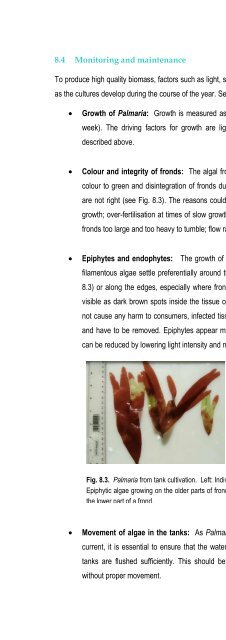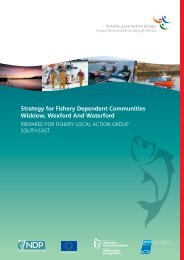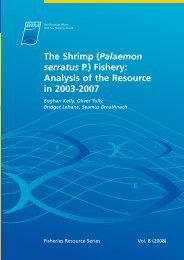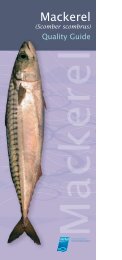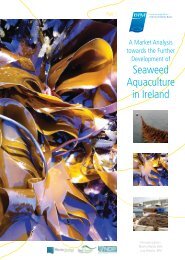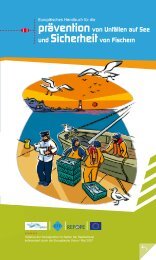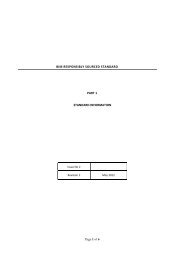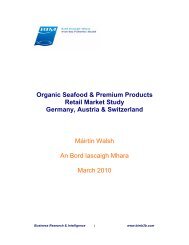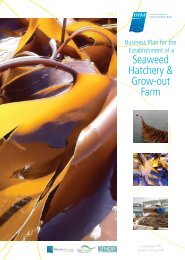Cultivating Palmaria palmata - Bord Iascaigh Mhara
Cultivating Palmaria palmata - Bord Iascaigh Mhara
Cultivating Palmaria palmata - Bord Iascaigh Mhara
You also want an ePaper? Increase the reach of your titles
YUMPU automatically turns print PDFs into web optimized ePapers that Google loves.
8.4 Monitoring and maintenance<br />
To produce high quality biomass, factors such as light, stocking densities and nutrient supply should be adjusted<br />
as the cultures develop during the course of the year. Several factors should be monitored on a frequent basis:<br />
Growth of <strong>Palmaria</strong>: Growth is measured as increase in biomass over time (e.g. kg wet weight per<br />
week). The driving factors for growth are light, nutrients and, to a lesser extent, temperature, as<br />
described above.<br />
Colour and integrity of fronds: The algal fronds should show a rich red-purple colour. A change in<br />
colour to green and disintegration of fronds due to parts dying off indicates that the culture conditions<br />
are not right (see Fig. 8.3). The reasons could be: too much light; nutrients depleted in times of rapid<br />
growth; over-fertilisation at times of slow growth; aeration too low and insufficient to tumble the fronds;<br />
fronds too large and too heavy to tumble; flow rate of seawater too small, resulting in too little flushing.<br />
Epiphytes and endophytes: The growth of epiphytes is easily detected. Small green or brown fine<br />
filamentous algae settle preferentially around the stipes of <strong>Palmaria</strong> and on old thallus parts (see Fig.<br />
8.3) or along the edges, especially where fronds have been torn into smaller pieces. Endophytes are<br />
visible as dark brown spots inside the tissue of older parts of <strong>Palmaria</strong> thalli. Although endophytes do<br />
not cause any harm to consumers, infected tissue parts will not meet the quality demands for foodstuff<br />
and have to be removed. Epiphytes appear mainly from the spring until autumn. Growth of epiphytes<br />
can be reduced by lowering light intensity and nutrient concentrations in the seawater.<br />
Fig. 8.3. <strong>Palmaria</strong> from tank cultivation. Left: Individuals which are damaged and/or bleached. Right:<br />
Epiphytic algae growing on the older parts of fronds; new fronds have grown out from the margins of<br />
the lower part of a frond.<br />
Movement of algae in the tanks: As <strong>Palmaria</strong> is a species which grows best at sites with a strong<br />
current, it is essential to ensure that the water in the tank is agitated by strong aeration and that the<br />
tanks are flushed sufficiently. This should be checked daily because <strong>Palmaria</strong> thalli die off quickly<br />
without proper movement.<br />
55


